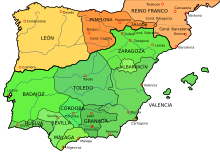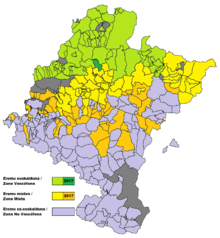User:Linettes99/sandbox
[edit]
Languages[edit]

According to what was established in Amejoramiento del Fuero, a Spanish law that issues basic institutional rule in the foral community of Navarra, Castilian is the official language of Navarre while the Basque language is also the official language in Basque-Speaking areas. The Statutory Law of Basque of 1986 grouped these areas, creating the Basque-Speaking Zone, an area Northeast of Navarre in which Basque is the co-official language with Castilian. This law recognizes Castilian and Basque as Navarre's lenguas propias (a Spanish legal term meaning that a language in an autonomous community in Spain has co-official status along with Castilian).[1]
According to official statistics, Castilian is the mother tongue of 81.9% of the population, Basque is 5.7% of the population's mother tongue, and 3.8% of the population has both languages as their mother tongue while 6.1% of the population have another language as their mother tongue.[2] The number of people that recognize Basque has increased in Navarre.[3] In 2011, 13.6% of the population in Navarre considered themselves to be speakers of Basque and 14.5% considered themselves as semi-speakers of Basque.[4]
Historically, other languages have been spoken, but have disappeared, in the present day, such as Navarro-Aragonese that arose the middle ages beneath the rivers of Ega, Arga, Aragon, and Ebro through the Spanish kingdom. In the eight century, Navarro-Aragonese became the written language in the court and royal administration and in 1329 it reached official status as the official language of the kingdom.[5] However, during the sixteenth century, the kingdom was later dominated by Castilian in comparison to Navarro-Aragonese.[6] Other languages such as the Occitan language, French, Hebrew, and Arabic also held statuses as minority languages.
Linguistic Division of the Territory and Legal Consequences[edit]

Castilian and Basque are defined as Navarre's lenguas propias according to the Foral Law 18/1986 of Basque.[7] According to this law, Navarre is linguistically divided in three areas, a Basque-Speaking Zone (where Basque is the dominant language), a Mixed-Speaking Zone (where Basque and Castilian are both dominant) and a Non-Basque Speaking Zone (where Castilian is the dominant language).
Castilian is the official language in the area of the entire community. However, Basque is the co-official language in the Basque-Speaking Zone. Additionally, the Basque Law has provisions that guarantee that Basque will be used in the Mixed-Speaking Zone. In the Non-Basque Speaking Zone, the public entities of Navarre only have the obligation of using Castilian.
The area of the municipalities belonging to Basque-Speaking and Mixed Basque and Castilian Speaking zones are the following:[7]
- Basque-Speaking Zone: Abaurrea Alta, Abaurrea Baja, Alsasua, Anué, Araiz, Aranaz, Arano, Araquil, Arbizu, Areso, Aria, Arive, Arruazu, Bacáicoa, Basaburúa Mayor, Baztán, Beinza-Labayen, Bertiz-Arana, Betelu, Burguete, Ciordia, Donamaría, Echalar, Echarri Aranaz, Elgorriaga, Erasun, Ergoyena, Erro, Esteríbar, Ezcurra, Garayoa, Garralda, Goizueta, Huarte-Araquil, Imoz, Irañeta, Ituren, Iturmendi, Lacunza, Lanz, Larráun, Leiza, Lesaca, Oiz, Olazagutía, Orbaiceta, Orbara, Roncesvalles, Saldías, Santesteban, Sumbilla, Ulzama, Urdax, Urdiáin, Urroz de Santesteban, Valcarlos, Vera de Bidasoa, Villanueva de Aézcoa, Yanci, Zubieta y Zugarramurdi.
Later, two more municipalities would be added that came from the Basque-Speaking Zones : Lecumberri and Irurzun.
- Mixed-Speaking Zone: Abárzuza, Ansoáin, Aoiz, Arce, Atez, Barañáin, Burgui, Burlada, Ciriza, Cendea de Cizur, Echarri, Echauri, Valle de Egüés, Ezcároz, Esparza de Salazar, Estella, Ezcabarte, Garde, Goñi, Güesa, Guesálaz, Huarte, Isaba, Iza, Izalzu, Jaurrieta, Juslapeña, Lezáu, Lizoáin, Ochagavía, Odieta, Oláibar, Olza, Ollo, Oronz, Oroz-Betelu, Pamplona, Puente la Reina, Roncal, Salinas de Oro, Sarriés, Urzainqui, Uztárroz, Vidángoz, Vidaurreta, Villava, Yerri, Zabalza y Zizur Mayor.
As a consequence of the constitution of new municipalities, other municipalities would be added: Berrioplano, Berriozar, Orcoyen y Zizur Mayor. Moreover, in 2010 a legal modification granted four municipalities of Cuenca de Pamplona the power of incorporating into the Mixed-Speaking Zone if the absolute majority decided to be incorporated into the Mixed-Speaking Zone. Aranguren, Belascoáin y Galar decided to be incorporated into the Mixed-Speaking Zone while Noáin decided to remain in the Basque-Speaking Zone.
One modification to the law implemented in June 2017 allowed municipalities from the Non-Basque Speaking Zone to become a part of the mixed zone 44 (Abáigar, Adiós, Aibar, Allín, Améscoa Baja, Ancín, Añorbe, Aranarache, Arellano, Artazu, Bargota, Beriáin, Biurrun-Olcoz, Cabredo, Dicastillo, Enériz, Eulate, Gallués, Garínoain, Izagaondoa, Larraona, Leoz, Lerga, Lónguida, Mendigorría, Metauten, Mirafuentes, Murieta, Nazar, Obanos, Olite, Oteiza, Pueyo, Sangüesa, Tafalla, Tiebas, Tirapu, Unzué, Ujué, Urraúl Bajo, Urroz-Villa, Villatuerta, Cirauqui y Zúñiga) and for Atez to pass from the Mixed-Speaking Zone to the Basque-Speaking Zone.[8]
- Non-Basque-Speaking Zone: This zone is composed of the remaining municipalities that are located predominantly towards the Southeast of the foral community where the Basque language is not commonly spoken by the population. However, more people have been speaking Basque in these communities and in present day, there are municipalities in which 10% of their inhabitants are bilingual or semi-bilingual in Basque and Castilian such as in Tafalla, Sangüesa y Lumbier. In comparison, in Tafalla or Sanguesa's population those that speak or understand Basque well are 5% of the population or 10% en Lumbier. In other localities with ikastolas such as in Fontellas, Lodosa y Viana the bilingual population is around 2% and 8%, while those that speak or understand Basque well are 1% in Fontellas, 2% in Lodosa and 5% in Viana.[9] Since 2006-2007 the schools that teach Basque in the Non-Basque Speaking Zone are assisted by the Department of Education of the government of Navarre.[10]
Denomination of Local Entities[edit]
The official denomination of Navarran municipalities and villages are regulated according to the Foral Basque Law.[7][11] It distinguishes three different types of formulas:
- Unique denominations: the use of Basque in legal documents is the same when compared with Castilian independently. Examples: Lantz or Beintza-Labaien.
- Compounded denominations: They have a unique denomination formula formed from the Castillian and Basque toponyms in Castilian or Basque and are united by the symbol "/". Its use (the compounded denomination) is the same in Castilian as in Basque. Examples: Auritz/Burguete, Roncesvalles/Orreaga, Luzaide/Valcarlos or Doneztebe/Santesteban.
- Double denominations: The toponym, in Basque or Castilian is dependent on the language and how it is used in the text. Examples: Pamplona<>Iruña, Villava<>Atarrabia, Aibar<>Oibar.

[edit]
Basque in Navarre has various dialects (there are nine according to the classification of the General Basque Dictionary or the Royal Academy of the Basque Language). According to the most recent classification of Koldo Zuazo, the most widespread dialect is Navarro-Aragonese which is spoken in the Central and Northern part of Navarre. In localities such as Basaburua Mayor, Imoz and other border localities with Guipuzcoa, the dialect of Central Basque is spoken and in the central part of the Navarran Pyrenees a variety of Navarro-Labortano is spoken. Towards the East of the Navarran Pyrenees, in the valleys of Roncal y Salazar, Basque used to be spoken, but it disappeared near the end of the twentieth century (the last person who spoke it in Roncal died in 1991 and in Salazar the language also disappeared because the last person who spoke it in Salacenco fluently died during the first years of the twenty-first century).
Apart from dialects, sub-dialects from Basque also exist and there are also differences in vocabulary in local linguistic communities.
[edit]
Grammatically, there are also significant differences, such as the predominance of the diminutive with -ico or the use of the conditional verb tense in place of the preterite of the subjunctive (for example, using podría instead of pudiera). Moreover, there also exist many differences in the vocabulary of Castilian Speakers in Navarre.[12] In addition to all these features in Castilian Spanish in Navarre, there is the presence of vocabulary of Basque origin that is in some cases due to the presence of a Basque substrate or longstanding contact and commercial exchanges with areas of Navarre in which Basque is still spoken.[13]
Linettes99 (talk) 16:55, 7 June 2019 (UTC)
- ^ Diccionario de la lengua española (23rd ed.). Real Academia Española y Asociación de Academias de la Lengua Española. 2014. ISBN 978-84-670-4189-7.
- ^ "Statistics of Navarra from 2011 Census".
- ^ "38% of new alums that arrive to UPNA from Bachillerato know Basque". Archived from the original on 2009-01-07.
- ^ "Statistic Institute of Navarra".
- ^ Cierbide, Ricardo. Notas gráfico-fonéticas sobre la documentación medieval navarra.
- ^ Herria, Euskal. Lugar de encuentro de lenguas y culturas.
- ^ a b c "Foral Law 18/1986".
- ^ "44 Navarran Localities Win Rights for Basque language through 'mixed zone'".
- ^ "Institute for Statistics of Navarra".
- ^ "Diario de Noticias de Navarra". November 15, 2006. Archived from the original on 2007-09-27.
{{cite web}}: Check date values in:|date=(help) - ^ "Navarra.es".
- ^ Irribaren, Jose María. Vocabulario navarro, Pamplona: Institución Príncipe de Viana, 1984 y Carmen Saralegui, Cristina Tabernero: Navarrismos en el diccionario de la Real Academia Española, Pamplona: Gobierno de Navarra, Departamento de Educación y Cultura, 2001.
- ^ "Las fronteras de la lengua vasca a lo largo de la historia" (PDF). Archived from the original (PDF) on 2007-01-15.
